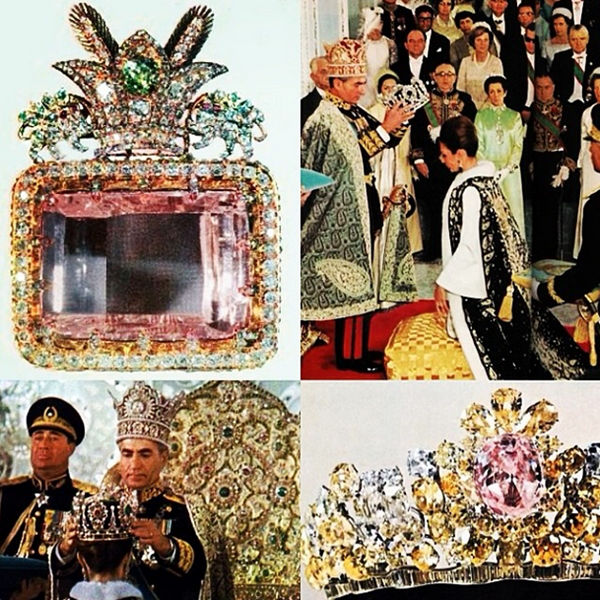World's Largest Pink Diamond - The Darya-ye Noor
- Home /
- Famous Diamonds /
- Allnatt Diamond
When it comes to diamonds of historical significance, the Darya-ye Noor diamond is difficult to surpass. Not only does this stone remain the largest pink diamond ever discovered, but it's also one of the oldest of its color in the world. With a 17th century origin, a remarkable size and unparalleled quality, this pink diamond is not your average gem.
In fact, the Darya-ye Noor comes with a rich history, royal heritage and fascinating story, all of which only add to its intrigue as well as its value.
 World's Largest Pink Diamond - The Darya-ye Noor
World's Largest Pink Diamond - The Darya-ye NoorImage via http://instagram.com/p/oqnBsVMavT/
Here's what you should know about one of the most celebrated colored diamonds in the world.
SEE ALSO: Largest Blue Diamond in the World Just Discovered!
Origins
Today, the Darya-ye Noor is part of the Iranian Crown Jewels. However, it had a long journey before it was given this prominent placement. According to the Iran Chamber Society, the diamond was more than likely unearthed in Southern India's Golconda Mines. It's believed that both the Darya-ye Noor and the Noor-ol Ein, which is part of the Iranian imperial tiara, originally came from the Great Table Diamond. Jeweller Magazine reported that this is because after several Canadian gemologists were looking at the Iranian crown jewels in 1969, they noticed that both stones had nearly the same exact color and clarity.
Famous Diamonds revealed that the Darya-ye Noor is thought to initially be owned by the first Mogul emperor of India, along with the Koh-i-Noor diamond. These stones were then passed down to Mohammed Ali Shah, and when Persia's Nadir Shah defeated him in the sack of Delhi, he had to give up all of his valuable pieces. Nadir then reportedly brought the Darya-ye Noor and the Koh-i-Noor back from India. Iran Chamber Society noted that Nadir's grandson, Shahrokh Mirza, took possession of the stones following Nadir's death. After that, Alam Khan Khozeimeh was apparently the owner, and then Lotfoli Khan Zand, a member of Iran's Zand Dynasty, had the Darya-ye Noor in his collection. When Agha Mohammad Khan, founder of the Qajar dynasty, was victorious over the Zands, the diamond was acquired by the Qajars. Later, Fathali Shah Qajar would even inscribe his name on one facet of the stone. After that, founder of the Pahlavi dynasty Reza Shah donned the Darya-ye Noor as a military hat adornment for his coronation in 1926. It was also worn by Mohammad Reza Shah Pahlavi's for a similar ceremony in 1967.
Famous Diamonds explained that some experts assert the East India Company eventually acquired the Darya-ye Noor and displayed it at London's Crystal Palace Exhibition in 1851. However, in a twist of events, officials at the Central Bank of Iran where the crown jewels are housed insisted to the Gemological Institute of America that the stone never left the Treasure Vaults.
Properties
While Famous Diamonds proposed that the Darya-ye Noor is a whopping 186 carats, the exact weight of the table cut diamond is unknown because removing it from the mid-19th century setting could potentially cause major damage. Still, the source reported that the GIA estimates this gemstone to weigh between 175 and 195 carats. The dimensions of the Darya-ye Noor, according to the Iran Chamber Society, are 7.2 centimeters high and 5.3 centimeters wide. This light pink diamond is also believed to be cut from the legendary Great Table Diamond.
Internet Stones noted that Edwin Streeter commented on the stunning appearance of the Darya-ye Noor in his book "The Great Diamonds of the World," published in 1884.
"[The Darya-ye Noor] is a magnificent stone of the purest water, and almost matchless luster, fully deserving the proud title of 'Sea or River of Light,' ..."
In his book, Streeter also confirms the weight of the stone to be exactly 186 carats.
Though the clarity of the diamond is also unknown, Internet Stones explained that it's no doubt extraordinary, as it came from a Golconda Mine, which is known for producing some of the most awe-inspiring gems in existence. The news source reported that the stone appears to be completely pure, and exhibits exceptional limpidity - which basically refers to the brilliance.
Furthermore, the Darya-ye Noor likely boasts a Type IIa grading. These diamonds contain either undetectable amounts of nitrogen or none at all, making them ultra rare and sought-after.
